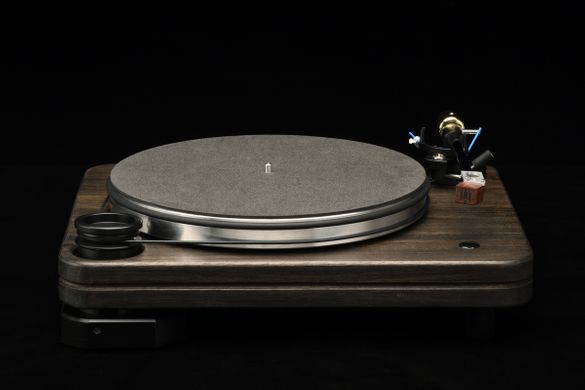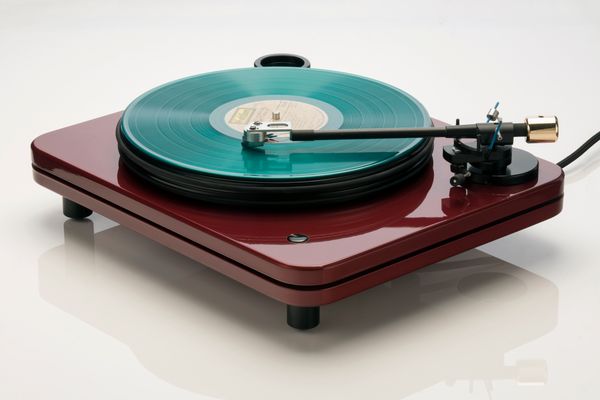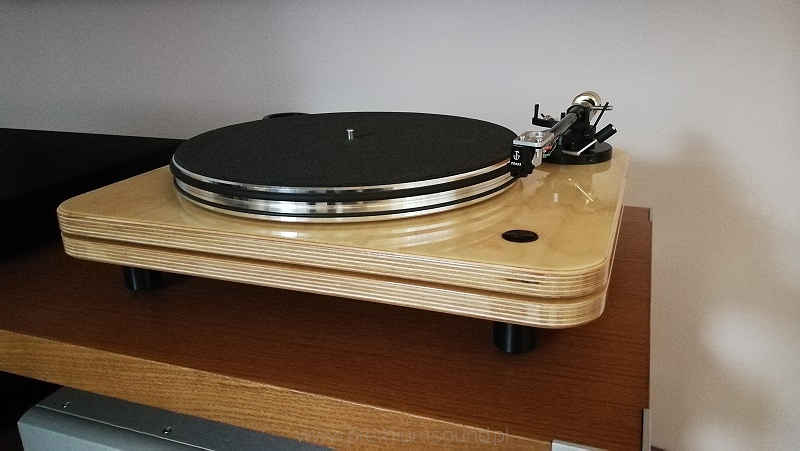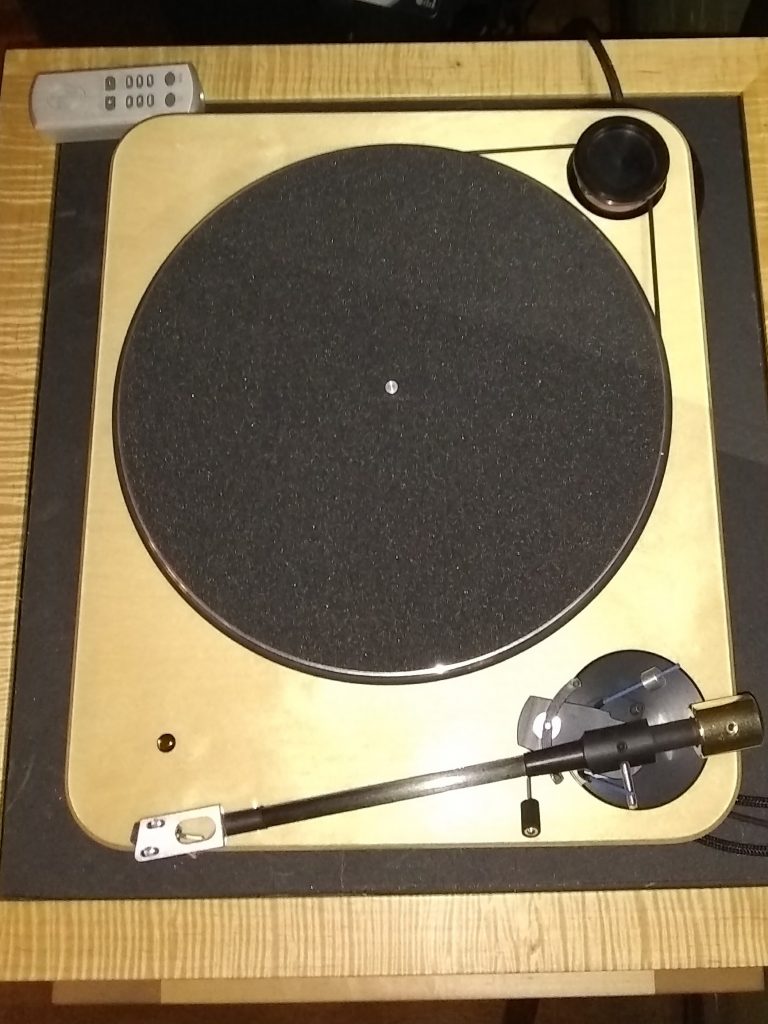Little John

Produsent: Pear Audio
Pris: 17500 til 21000 avhengig av finish
Beskrivelse
Little John
Pear Audio Blue turntables and tonearms do not represent a revolution, but rather an evolution in Tom Fletcher’s approach to turntable design.
Based on Tom Fletcher’s Blue, Little John uses the same motor principle and the motor still has to be initially spun by hand. This motor principle drastically reduces the resonance going from the motor to the platter and ensures speed accuracy.
Little John features an essential parameter in turntable design: matching materials able to control resonance naturally and that are sonically in phase. Components are selected to work perfectly together, making the whole more than the sum of its parts – creating a turntable in sonic harmony.
Special attention has been placed on a new bearing development along with a new and improved plinth. An improved motor arrangement and a different platter were implemented along with other improvements to achieve superior organic sound quality. The perfect marriage of materials results in astonishing realism, tonal quality and balance, with a realistic and deep 3D soundstage. You’ll be able to hear an astonishing, near-live performance of your favorite musicians.
Each model is hand built upon the same design principles, and all offer high performance sound, quality build and value way beyond their price.
Pear Audio Blue Little John/Cornet 1 Turntable
May 6, 2018So, months, days and year (no "s") into my sojourn with the Pear Audio Blue Little John (system par excellence), I've hit critical mass. I'm taken, enamored, sold-on, dedicated, committed to and otherwise fully engaged with this turntable life. Without spending another three-thousand-plus words telling you all the ways I'm madly in love with the system itself I thought I'd attempt to drill down into what the system means to me and to my everyday listening habits and how those habits have changed and evolved (and even regressed) in response to the addition of such a phenomenal turntable system in my house and in my life.
Ohhhh…can we just jump to the end? One big reveal, hold the pickles? In my previous musings on the Pear Audio Blue Little John/Cornet 1 turntable/tonearm/plus extras/oh my goodness, I wrapped up my humble wordsmithing with "Oh, and I am absolutely stacking my shekels in advance of my purchasing my first turntable. You see, when this review comes to an end, as all reviews must, the turntable sized hole in my heart will need prompt filling." Soooooooo…I bought the thing. All of it. Lock, stock and bone broth (stock pun, FTW). This beautiful statement of audio decadence is now on permanent exhibition in my living room. It is not going back. That is how much I loved what the Pear Audio Blue Little John (plus Kung Fu Grip accessories) brought to my world. So, with that bombshell out of the way…
The immediate impact of this system on my day-to-day life is…space. Namely how I use it and how I interact with the space the system occupies. Before the arrival of the Little John, and all of it's amazing accoutrements, I'd never had an issue finding room to setup and spread out when demoing equipment. I literally have a half-dozen areas throughout the house that have served as listening and/or staging areas. I could spread out, cables and manuals and bubble wrap all willy-nilly, covering every semi-clear surface in a patchwork that resembled nothing more than fancy adult audio-legos. I knew going into this that the time had come for me to set aside real space, to commit to the spatial requirements of a rack and parts and stuff (this doesn't always have to be metaphors and flowery language). This seemed at first blush a damning limitation. Despite my homebody leanings I'm a mobile guy, on the move and on the go. My collection is primarily constructed of "personal" audio equipment. Headphones, mobile DAC's, small-ish formfactor amps and the like make up the majority of my audio universe. I've always delighted in the opportunities I've had listening to "systems", those big-boy setups that cost more than my home and have the ability to regulate the air pressure in their native environs. The rooted-ness of this particular turntable (and "parts") has imposed heretofore unknown restrictions upon my listening, and more importantly (to me) my sharing of the audio goodness.
Hey! There's another huge chunk of my audio predilections popping up here…the ability to share my audio enjoyment with others. I'm a share-er, obviously (I mean, here we are). The music I get to experience and my ability to share said music is intrinsic in my enjoyment of music, full stop. If there is an easily attributable constant in my life that lives up to the vague descriptions of The Force (all Lucasfilm's/Marvel's/etc. rights and copyrights reserved and attributed to Darth Lucas or Kathleen Kennedy or whomever) it would be the sharing of Music (with that capital "M"). For me music is one of those rare and special things that surrounds us, penetrates us and binds us together.
So, space. My supply of it is limited, yet I didn't expect it to play such a large part in my understanding, evaluation and enjoyment of the turntable. Having a "positioned" and "permanent" placement, the turntable became at once a focal point of the room and an expensive liability. Take two young boys, a household full of toys and a living room that most often resembles a cage-fighters gym and you can imagine the imminent dangers facing a rack of audio delivery devices. That balloon? It's a static-conveying unmanned weapon. Those soft, foam Ikea soccer balls? They might as well be flaming trebuchet ammo. The Nerf swords, axes and so, so, sooooo many dart-guns? All somehow magically aimed at the tonearm every single time. It's a battlefield on the best of days and I (knowingly) placed this all-important turntable and "bits" directly into it. Oh my. Yet my boys were intentionally aware of this new and imposing monument to sound that had invaded "their" room. They were (are) careful and even more impressively, respectful of both the placement and the contents occupying the CMS rack. I suppose I could attribute this to the passage of time and their increases in age, but I'd rather attribute this to their burgeoning appreciation of music in all its varied forms. I've been collecting grin-inducing memories of my youngest son running full speed towards the turntable only to come screeching to a halt a mere foot away, to then look over to me and mock-seriously say "Careful! That's Daddies stuff… no touching!" He gets it. And that awareness on the part of my sons has been a very, very cool development.
Speaking of my sons, time comingles with space in the orbit of the Little John. With most of my audio equipment there is a hidden timer built in, ticking down ever so slowly towards the day when its technology has been surpassed and rendered secondary if not (shudder) entirely obsolete. With the Little John (and friends) I have an honest to goodness ageless wonder on my hands. I've also got and investment on my hands, the sort that's been around in one form or another for over 140 years (that's way too much on my hands now, they're getting tired). Not an investment of the "buy low, sell high" kind, but of the "one day I can pass this down to my sons" kind. Where my DACs could falter, where my SACDs may be replaced by holographical storage cubes and my headphones displaced by laser-guided audio waves that are transmitted directly to my eardrums, my turntable will (should; may) persevere. The vinyl discs I am purchasing now will still, handled carefully, be around as my boys become adults and (hopefully) engage with music in the own personal and unique ways. How awesome is that? Yet another blissful byproduct of this turntable love.
It hasn't all been growth and sunshine though. With the advent of Spotify and Tidal I've become less and less dependent on format as a factor in my daily music consumption. My Astell & Kern AK240 has built-in Tidal support and my phone has apps for ALL the major music services. Nowadays wherever I go I have the ability to reach out and pluck a decently encoded, high(ish)-format album or song and play it back on whatever gear I have readily available. Car? Check. Work? Check-check. Friends house? Check again. Bar? Check and mate. This abundance of previously unknown audio options has desensitized many a listener to the more refined and detailed audio formats. Purchasing all of your music on expensive circles of vinyl, which often each cost double the monthly subscription fees of the popular music streaming services, becomes difficult to justify for those on a budget. The appeal of sonic gains is tempered by the ubiquity of the medium. Thusly my diving into the vinyl life has presented (even) me with something of a conundrum. How I engage with music on a daily basis has come to depend just as much on the dollars in my account as it does the technology in my home and the time I have available to listen. To re-buy or not to re-buy has become a common question this past year. Heck, to buy on vinyl at all has become an accompanying question to almost every music purchase I've made in the self-same past year. A dollar is a dollar and my supply of them, like most people's, is limited. Sure, I've felt especially fancy reaching for the limited run record on the merch table after a concert (Jeremy Enigk; his first "living room show" EVER where I greedily snatched up a copy of Ghosts, I'm thinking of you). And yes, the greater part of my music purchases over the last year have been in the vinyl format, cost be dangnabit-ed. But still, and it pains me to say this, my overall engagement with current music and my volume of listening to new music has diminished in direct proportion to my involvement and investment in vinyl. Jumping into turntable ownership has been rewarding in so many ways, yet it would be misleading to say that it has exposed me to more music. Rather, the financial restrictions that accompany purchasing vinyl has helped sharpen and focus my appreciation for music rather than broadening it. None of this is to say that one should hesitate to integrate a similar setup into one's own life. Just last month I gently guided an employee of mine towards their own first turntable purchase. So, like, Lasciate ogni speranza, voi ch'entrate, or, you know, proceed at your own pace and risk.
An unforeseen (to me) limitation/quirk/restraint of turntable enjoyment is that you cannot "just press play". Unlike listening through an mp3 player or PC playback, one should be intentional and purposeful when approaching a turntable. Every movement should be thought out in advance, lest you find yourself placing a dust jacket on the rightmost speaker or a record brush ever-so-momentarily on top of a preamp. To use a turntable is to practice the art of mise en place. Slow and deliberate movements, no skipping tracks or jumping from album to album. Think it through, plan it out, have a place to sit and a clear spot for your tasty beverage of choice. And don't come expecting to rock a quick single as you get ready to make dinner or prep for a night out. You must needs devote time to the experience, lest you miss out of the transmogrification of space, time and vinyl into magic. The art is real and the investment of time is absolutely essential to the enjoyment to be had. This, as much as any other factor, tempered my initial foray into the turntable experience. When I'm getting ready for work each morning I'm more likely to ping Alexa to play something on my Oppo Sonica then I am to spend the time necessary to drop needle on record. Sure, some mornings demand a seat on the sofa, a second cup of coffee, a cat on my lap and the haunting strains of Sea Change by Beck wafting gently through the living room. But the time and attention needed to do so are hard to come by. I don't spin discs while the boys are stampeding through the house and I don't spin discs while they're sleeping. My window in this regards is small and it takes forethought and planning to reach that window at all. Don't be dismayed though, the window when reached is spectacular. I now find myself planning listening time the same way I would plan dates with my wife, back when she was still just called girlfriend. Once I began to see the necessity of spending space and time to appreciate the total impact of the turntable on my audio world, well then I began to see it all.
A blessing amongst all the audio monetary drains is that the complete set of tonearm, cartridge, preamp, and table are so ridiculously competent, and punch so far above their weight that I am left wanting for little in the sonics department. However… I need to purchase a vinyl cleaning device/contraption. I have zero idea as to where it'd go (basement?), yet I keenly feel the need for it every time I open a new album. If you're at all familiar with the conundrum that is: A) Buy a choice album on vinyl, B) Open said album, C) Oh crap! The disc has dust/fuzzies/paper remnants/other detritus on it, D) But I want to listen NOW, then you know the pain that brings me to wanting (needing!) a disc cleaner. And of course, as with all life-changing musical purchases, the turntable (and accompanying modules) purchase is merely the kicking-off point for building out the surrounding ecosystem of components. New speakers, monoblock amplifiers, an audio-dedicated circuit breaker and balanced cabling all comes to mind. But before I hijack this article and turn it into a list of desired upgrades and add-ons (for the boss to consider as he ponders review assignments) I need to stop and admit something. If I'm being forthright, if I skip past all the little verbal thrusts and get to the heart of the matter, I'd be telling you that no purchase short of a new house is going to seriously impact this kit. I'm maxed out, you see. Room is the premium I am unable to pay at the moment. So while I'd like to investigate the arcane sounds of tube amps, while I'd like to super-size the speakers attached to the turntable, I am currently at an impasse. And that's fine. The enjoyment of this system is not diminished in the slightest due to any space constraints. I sometimes feel like I'm looking through time and space, past whatever sparkly bauble or gewgaw has caught my eye, and I see that the shine still hasn't worn off the Little John.
If you couldn't tell from the words here (or you jumped over the preceding paragraphs) I get a lot of enjoyment out of the Pear Audio Blue Little John turntable. A lot. A WHOLE LOT. The (a) unexpected benefit of blessing my abode with a turntable (and its accompanying gizmos) is that when I go to share it with friends (or those enemies whom we're supposed to keep even closer than friends) there is a clearly demarcated space for the listening to and enjoyment of said device(s). Almost all of my previous hi-fi "statement pieces" are of the mobile and/or easily moveable sort, making just about any seat a great seat for listening to whatever recent addition I happen to be showing off. The use of my living room has changed dramatically with the addition of the Pear Blue Audio set. People congregate. They rifle through the albums I own and comment on being surprised at this or shocked at the absence of that. When's the last time someone opened up your computer and scrolled through your downloads folder or perused your Tidal playlists? Never, and that social connection I experience with the turntable is just as much the reason why I bought the thing as is anything else. As with most finely-crafted things, people want to look and examine and understand just what it is they're confronted with and why it has captured their attention so dramatically. I can't keep track of how many times friends have asked me to write down the name or manufacturer of a piece of audio equipment they've heard through me. With the Little John though, not a soul has inquired. This isn't a slight, see, but a thinly-veiled compliment. When I've queried said friends after a rousing listening session they have all, to a person, said that they didn't ask because with such a detailed and immersive sound they just couldn't believe there was any way they would be able to afford it. Now we're not talking pocket change but we're also not talking the price of a new car. A common thread throughout much of my audio collection is a very competitive price-to-performance ratio. The exponential expenditure of funds to reach greater audio gains is not a well kept secret. I've been proud that the audio pieces I do own for the most part float comfortably in the lower-priced end of the high-end audio pool. Accessible to friend and foe alike, though only the friends get listen to my equipment. And that's another delightful thing about owning a turntable. It's socially contagious. Who knows, you may be the focal point for vinyl discovery amongst your friends.
To summarize: Soooooooo… I bought the thing. I mean, what else was there to do? I live in Portland and I'm a middle-class (wanna-be) intellectual. If I can't debate Portland's best authentic New Mexican cuisine while drinking small-batch artisanal bourbon out of mason jars while unironically listening to a re-issue of Either/Or on a record player while the house doors are open so that the sound of buses and passers-by drown out the music, well, what am I even doing? All kidding aside, the impact of the Pear Audio Blue Little John/Cornet 1 turntable/tonearm on my day-to-day life has been transformative. It has transformed how I listen to music. It has transformed how I share music with others. It has transformed how I purchase music and what I plan to purchase component-wise. And now, let's replace the word "transformed" with "improved". Because that is honestly what this setup has done. Every facet of my audio world has changed, for the better, with the addition of this turntable and components. I had to buy this, absolutely, positively had to. I have discussed and debated many an audio purchase with my wife over the years. Some of these purchasing decisions I (we, totally we dear) have triumphed in (my ever-trusty Mytek Stereo-192 DSD-DAC) and some purchases I have sadly missed out on (pour one out for the Cavalli Liquid Carbon Headphone Amplifier). When the time came to decide whether or not the Pear Audio Blue Little John was going back to Michael Vamos of Audio Skies, the US distributor of Pear Audio Blue, there was really no discussion. It just had to stay. And stay it has. And stay it will for a long, long time to come.
Fletcherism...
My friend Tom Fletcher likened most modern audio products to a brass violin:
"Pretty to look at but not something you'd want to try to play music on! We don't want to make brass violins, no matter how many
we could sell.“
With this simple phrase, Tom’s philosophy about music and audio design is crystalised.
At Pear Audio Analogue we have a passionate commitment to hand-build fine instruments for the playback of recorded music.
We’re not interested in the quick and easy answer, but believe objects of real worth take time to create.
First and foremost, our team never forgets that what we’re trying to capture is - music.
Without music there is no purpose.
All aspects, from the size and shape of the parts to the materials they are made from, are subservient to the music.
Even the finish applied to various parts is carefully considered with respect to the effect it would have on the music. If making
something shinier results in poorer sound, we will find a different finish.
Every last detail, down to the type of rubber used in the feet on the plinth, has been tested for resonance characteristics and is then listened
to by trained ears. Nothing is left to whim.
The design of our turntables and tonearms follow a key philosophy - achieve a magnificent marriage of materials. Each material, on its own, might be common and unremarkable, but the way materials perform together, to maintain the proper phase of energy throughout the system, is how the magic begins.
No frequency is overly diminished or amplified. No frequency is overly damped or allowed to sustain. Every bit of energy is carefully managed across the spectrum, from the motor itself, through the tone-arm and in the stylus as it is driven by the grooves on the record.
Thus a turntable where the whole is worth more than the sum of its parts is created.
From the ultra-low torque motor, to the mechanically damped unipivot tone-arms, these seemingly simple-looking turntables have loads of clever engineering skill concealed within them.
Give a Blue a spin today!
Spesifikasjoner
Tone-arms

Unipivot arms are usually designed with the pivot sitting in a silicone bath. The problem with this design is that the silicone bath takes quite a while to settle down, so the sound of the arm changes as it plays. Many unipivots uses eccentric counter weights to insure proper azimuth.
Cornet’s unipivot design uses a new approach: to maintain azimuth, along with a special material, developed with viscosity properties that do not flow and do not require “settling time”.
A hi-tech carbon fibre tube with fibres along the length, not wrapped around the arm, greatly increases the strength, resonance control and rigidity of the arm.
Cornet arms also have an unusual new headshell design. Meticulous attention to the material went into the development, producing an arm more sonically in phase. The headshell also has no finger lift. These features ensure that the arm is properly balanced and no uncontrolled resonances run around the headshell.
The Cornet 1 tonearm shares most of the same performance features of the more expensive Cornet 2 - long grain Carbon fiber, Unipivot design, in-line headshell and a magnificent marriage of materials.
All our arms share the same - family of sound - we believe, they have to, in order for all to sound right in combination. Thereby the differences between the two arms are subtle yet still clearly audible.
Specification : 10" Cornet 2
Distance from Tone arm center to spindle: 222mm
Effective mass: 12, 50 grams
Arm's length: 29,50mm
Tonearm effective length: 239m




